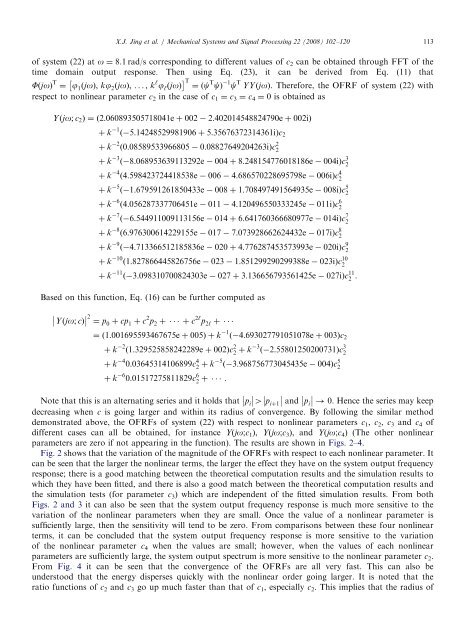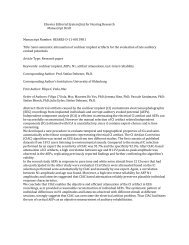Output frequency response function-based analysis for nonlinear ...
Output frequency response function-based analysis for nonlinear ...
Output frequency response function-based analysis for nonlinear ...
You also want an ePaper? Increase the reach of your titles
YUMPU automatically turns print PDFs into web optimized ePapers that Google loves.
of system (22) at o ¼ 8.1 rad/s corresponding to different values of c2 can be obtained through FFT of the<br />
time domain output <strong>response</strong>. Then using Eq. (23), it can be derived from Eq. (11) that<br />
FðjoÞ T ¼ j1ðjoÞ; kj2ðjoÞ; ...; k ‘ j ‘ðjoÞ T ¼ðc T cÞ 1 c T YYðjoÞ. There<strong>for</strong>e, the OFRF of system (22) with<br />
respect to <strong>nonlinear</strong> parameter c2 in the case of c1 ¼ c3 ¼ c4 ¼ 0 is obtained as<br />
Yðjo; c2Þ ¼ð2:060893505718041e þ 002 2:402014548824790e þ 002iÞ<br />
þ k 1 ð 5:14248529981906 þ 5:35676372314361iÞc2<br />
þ k 2 ð0:08589533966805 0:08827649204263iÞc 2 2<br />
þ k 3 ð 8:068953639113292e 004 þ 8:248154776018186e 004iÞc 3 2<br />
þ k 4 ð4:598423724418538e 006 4:686570228695798e 006iÞc 4 2<br />
þ k 5 ð 1:679591261850433e 008 þ 1:708497491564935e 008iÞc 5 2<br />
þ k 6 ð4:056287337706451e 011 4:120496550333245e 011iÞc 6 2<br />
þ k 7 ð 6:544911009113156e 014 þ 6:641760366680977e 014iÞc 7 2<br />
þ k 8 ð6:976300614229155e 017 7:073928662624432e 017iÞc 8 2<br />
þ k 9 ð 4:713366512185836e 020 þ 4:776287453573993e 020iÞc 9 2<br />
þ k 10 ð1:827866445826756e 023 1:851299290299388e 023iÞc 10<br />
2<br />
þ k 11 ð 3:098310700824303e 027 þ 3:136656793561425e 027iÞc 11<br />
2 .<br />
Based on this <strong>function</strong>, Eq. (16) can be further computed as<br />
Yðjo; cÞ 2 ¼ p0 þ cp1 þ c 2 p2 þ þc 2‘ p2‘ þ<br />
¼ð1:001695593467675e þ 005Þþk 1 ð 4:693027791051078e þ 003Þc2<br />
þ k 2 ð1:329525858242289e þ 002Þc 2 2 þ k 3 ð 2:55801250200731Þc 3 2<br />
þ k 4 0:03645314106899c 4 2 þ k 5 ð 3:968756773045435e 004Þc 5 2<br />
þ k 6 0:01517275811829c 6 2 þ .<br />
ARTICLE IN PRESS<br />
X.J. Jing et al. / Mechanical Systems and Signal Processing 22 (2008) 102–120 113<br />
Note that this is an alternating series and it holds that p i 4 p iþ1 and p i ! 0. Hence the series may keep<br />
decreasing when c is going larger and within its radius of convergence. By following the similar method<br />
demonstrated above, the OFRFs of system (22) with respect to <strong>nonlinear</strong> parameters c 1, c 2, c 3 and c 4 of<br />
different cases can all be obtained, <strong>for</strong> instance Y(jo;c1), Y(jo;c3), and Y(jo;c4) (The other <strong>nonlinear</strong><br />
parameters are zero if not appearing in the <strong>function</strong>). The results are shown in Figs. 2–4.<br />
Fig. 2 shows that the variation of the magnitude of the OFRFs with respect to each <strong>nonlinear</strong> parameter. It<br />
can be seen that the larger the <strong>nonlinear</strong> terms, the larger the effect they have on the system output <strong>frequency</strong><br />
<strong>response</strong>; there is a good matching between the theoretical computation results and the simulation results to<br />
which they have been fitted, and there is also a good match between the theoretical computation results and<br />
the simulation tests (<strong>for</strong> parameter c 3) which are independent of the fitted simulation results. From both<br />
Figs. 2 and 3 it can also be seen that the system output <strong>frequency</strong> <strong>response</strong> is much more sensitive to the<br />
variation of the <strong>nonlinear</strong> parameters when they are small. Once the value of a <strong>nonlinear</strong> parameter is<br />
sufficiently large, then the sensitivity will tend to be zero. From comparisons between these four <strong>nonlinear</strong><br />
terms, it can be concluded that the system output <strong>frequency</strong> <strong>response</strong> is more sensitive to the variation<br />
of the <strong>nonlinear</strong> parameter c4 when the values are small; however, when the values of each <strong>nonlinear</strong><br />
parameters are sufficiently large, the system output spectrum is more sensitive to the <strong>nonlinear</strong> parameter c2.<br />
From Fig. 4 it can be seen that the convergence of the OFRFs are all very fast. This can also be<br />
understood that the energy disperses quickly with the <strong>nonlinear</strong> order going larger. It is noted that the<br />
ratio <strong>function</strong>s of c 2 and c 3 go up much faster than that of c 1, especially c 2. This implies that the radius of

















